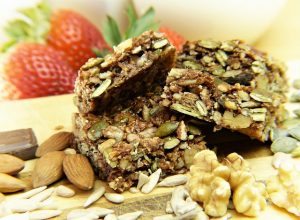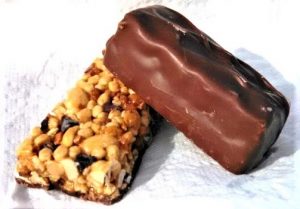 No matter the season or activity, energy bars are a convenient way to fuel your active lifestyle. The word ‘energy’ on the energy bar label means it has a lot of calories. Candy bars also provide energy from calories, so what is the difference? Sometimes there is not much difference; it all depends on the ingredients listed on the label. A balanced energy bar should include a variety of carbohydrates, protein, fiber and healthy fat.
No matter the season or activity, energy bars are a convenient way to fuel your active lifestyle. The word ‘energy’ on the energy bar label means it has a lot of calories. Candy bars also provide energy from calories, so what is the difference? Sometimes there is not much difference; it all depends on the ingredients listed on the label. A balanced energy bar should include a variety of carbohydrates, protein, fiber and healthy fat.
Things to Know and Look For in an Energy Bar:
Calories: Energy bars pack a lot of calories into a small amount of food. If you are trying to limit your calories, but just want some quick energy or to calm your hunger, they may not be the best choice. A better choice would be a handful of nuts and a small apple. An energy bar might be more appropriate for athletes, who burn lots of calories.
Fat: Some fat is good, because it slows the absorption of energy. This helps avoid a quick burst of energy followed by a quick fall of energy. Some fat also helps you absorb any fat soluble vitamins in the bar. Look for bars that provide less than 30% – 40% of the total calories from fat. Also look for healthy fats like nut oils and read the nutrition label. Avoid all Trans -fats and limit the saturated fat to no more than 10% of the total calories per serving.
Carbohydrates and Fiber: The quick energy boost in the bar comes from carbohydrates. To avoid a blood sugar spike and crash look for a bar with approximately 40% – 50% of the calories from carbohydrates. A combination of simple carbohydrates like sugar, honey, brown rice syrup, etc. and complex carbohydrates like whole grains is best. The simple carbs help with a burst of quick energy. The body processes complex carbs slower, which helps maintain energy longer. Fiber also helps slow absorption so look for a bar that has at least 3 grams of fiber per serving.
Protein: Some protein is good; it helps the body recover from muscle strain and provides a steady source of energy for the body. You can get too much of a good thing with protein, which can be hard on the kidneys. Choose a bar with no more than 20 grams of protein per serving.
Vitamins, minerals, etc.: Many bars are fortified with vitamins and minerals. As long as the fortification does not go over 100 of the recommended daily value and you are not limited by your doctor, these are usually fine.
Taste: Oh and they should taste good, why waste the time, money and calories on a snack that tastes like cardboard, leaves you with a bad aftertaste, is chalky or gritty, or gets stuck in your teeth/braces.
Store Bought or Homemade:
Energy bars can be purchased from just about any grocery or convenience store and many other retail outlets. This makes them easy to find in a variety of nutrition profiles and flavors. They come individually wrapped, portion controlled and ready to stash into a pocket, backpack, briefcase or purse. On the other hand you could make your own. The advantage to this is you get to control the ingredients, portion size and type of packaging. Homemade might not be as convenient, but oh so tasty!
 Tips to know
Tips to know
Young adults and teens are attracted to energy bars, believing these candy tasting bars will give them energy to study, help them develop bigger muscles, or if eaten as a meal replacement will help them lose weight.
Facts: Energy bars won’t make you leaner, smarter, stronger, or faster on their own
- Putting in quality study time, along with adequate sleep and nutrition can boost academic performance.
- Increasing physical activity, specifically lifting weights along with good nutrition helps muscle development.
- You still need to burn more calories than you consume to lose weight. Plan to be active enough to burn off the calories from the eating energy bars as a snack.
- Energy bars are great to carry as emergency food when you do not have time for a meal, or you forget your lunch, but they are not a good replacement for a balanced meal.
- Because the calories and nutrients are so compact in an energy bar, be sure to drink 6-8 oz. of water when eating them.

